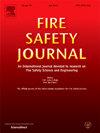Full-scale experimental study on combustion characteristics and smoke temperature of double-source fires in different tunnels
Abstract
Through a series of full-scale fire tests conducted in three different tunnels, the common characteristics of combustion and smoke temperature of double pool fires in actual operation tunnel environments are investigated. The evolution process of the coupling effects of shielding entrainment and thermal feedback enhancement is revealed. It is found that the ventilation state and the fire source spacing can alter the dominant relationship between the shielding entrainment effect and the thermal feedback enhancement effect, resulting in different evolution patterns of combustion characteristics and smoke flow patterns of double pool fires in tunnels. The heat release rate increases by 4 times when the double pool fire flames merge under the longitudinal ventilation compared with the double pool fire flames without fusion under the natural ventilation. The flame tilt angles of double pool fires were determined through the image processing method, and the prediction model of the flame inclination angle of downstream fire sources was established, considering fire source spacing. At the same time, the characteristic of temperature measured by Fiber Bragg Grating in double-source fire scenarios was investigated, developing a model to predict the longitudinal temperature rise distribution. It is found that the maximum temperature rise prediction model based on steady-state fire has poor applicability in the weak-plume fire scenario of full-scale tunnels. The analysis of the smoke flow patterns shows that the two-stage ventilation is more suitable for smoke control compared to full longitudinal ventilation in tunnel double-source fire accidents, especially for ensuring the safety of individuals trapped in the area between the two fire sources.

 求助内容:
求助内容: 应助结果提醒方式:
应助结果提醒方式:


